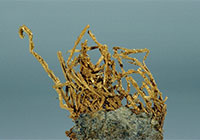Treasure of the month
February 2017
Special shape gold
Gold in the form of wires occurs very rarely in nature. Solid gold is usually found enclosed in other minerals as mountain gold or in sediments in the form of gold dust or as nuggets. Because this form of solid, or pure, gold is so rare and the history of this object is so unusual, gold is presented as the Treasure of the Month for February.
Originally, this treasure came from the Cajón del Maipo, in the southeast of the Chilean capital Santiago. Today the filigree object of 6 cm height can be admired in the Museum of Nature Hamburg - Mineralogy at the Grindelallee.
It was already on display in Hamburg's Natural History Museum before World War II, but its history goes back much further and is a piece of the city's history. This is because the gold belongs to a mineral collection that could only be reconstructed through extensive research and traced back to the geoscientist Dr. Carlos Alberto Joaquin Plagemann.
Born in Chile, Dr. Carlos Alberto Joaquin Plagemann returned to Germany in 1868 with his Hamburg father, the founder and owner of the first Chilean brewery in Valparaiso. He attended the Akademisches Gymnasium (Johanneum) here, then studied and earned his doctorate in mineralogy and mining in Marburg and Freiberg.
Between 1886 and 1888, he led several geoscientific expeditions to the Atacama Desert and finally returned to Hamburg in 1889, where he died in 1908.
Two years after his death, his sister bequeathed the extensive collection of Chilean minerals to the Hamburg Museum of Natural History. Today, the valuable collection is an essential part of the collections of the Museum of Nature - Mineralogy.
Photo: Gold crystals from Chile. Height: 6 cm; Photo: Karl-Christian Lyncker, Hamburg.


